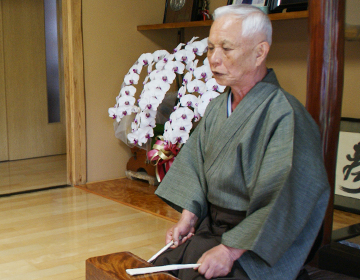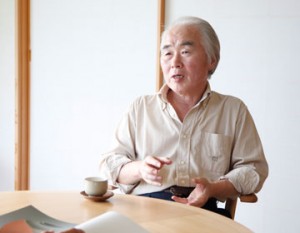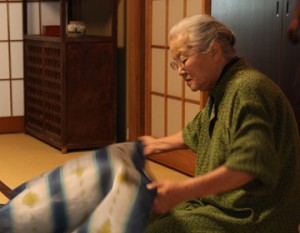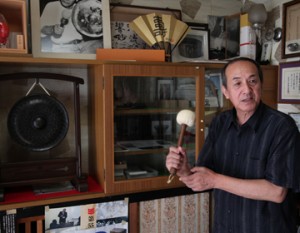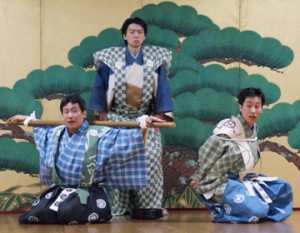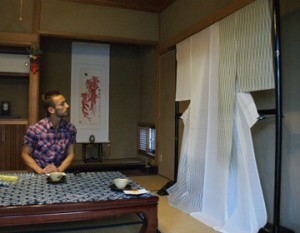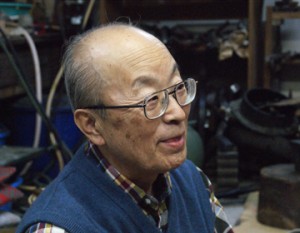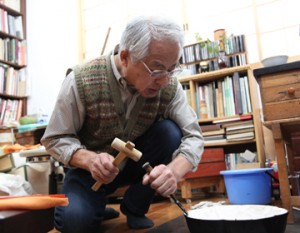Stage debut at 8
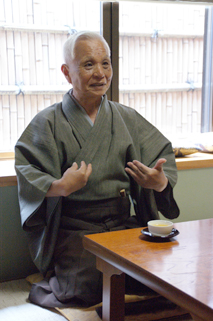
”The hayashikata of Noh are seated within view of the audience, so we always have to be careful.” These were the words of Nohgaku Hayashi Ohzutsumikata, Tadao Kamei. His father was the Kadono-ryu expert, Toshio Kamei and he was taught this artform that has continued from the Edo period since he was 5.
”I have simply been awed by my father’s performances since my childhood. He would teach me, but never in detail. He would never preach and would just instruct me by saying ”louder” or ”yes”. He taught with his actions.”
He studied under his father, who was designated a certified holder of an Important Intangible Cultural Asset; and Kawasaki Kyuen, then Kadono Ryu family trustee, and performed his first stage at 8. He had already decided this was his destiny by the time he was in the 3rd grade.
”We were all suffering from the losses of the war at the time. Yet I was determined to continue. There was something strong that motivated me.”
Collaborating to create the performance
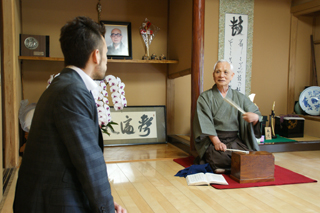
Kamei specializes in ohzutsumi in the Nohgaku hayashi. Just like his father, he was designated an Important Intangible Cultural Asset holder in 2002. ”Ohzutsumi is a lot of hard work,” he told us. As mentioned earlier, hayashikata of Nohgaku sits in view of the audience, so even a slight change in expression is visible to the audience. Just as the shitekata dances and the Noh chorus sings with a low tremor, Ohzutsumikata also need to convey the music with their entire body. ”Tsutsumi is so simple, it is a rudimentary sound. You go on stage and somehow create a sound that links the scenes with just the sound produced by the tsutsumi.” Kamei told us. Unless the kozutsumi, ohzutsumi, taiko, jiyou, and the performers all harmonize, the world of Noh will not be complete. Taiko has another role to signal hayashikata. It plays an important role in creating this unique world of Nohgaku.
Playing the Basic ”Sanji”

We observed the practice. Kamei acts as the instructor, taking on the singing and the kozutsumi, while his son Hirotada Kamei strikes the ohzutsumi. The call ”Yo” and the sound of the ohzutsumi vibrates in perfect timing with Kamei’s song.
”Do you want to try?” Nakata was invited to play the ohzutsumi. He was taught the basic actions of hayashikata called ”mitsuji” which combines the ”striking sound”, ”the voice calling out”, and ”komi (the silence of ”ma”). Nakata held the ohzutsumi on his side and used his right hand to strike it, but was only able to produce a dull sound.
”You need to snap your wrist to produce a good sound. Otherwise you’ll hurt your hand.” With this advice, a good sound with tension resonates. ”That was splendid.” An appraisal was given with a smile.
Movements with Elegance
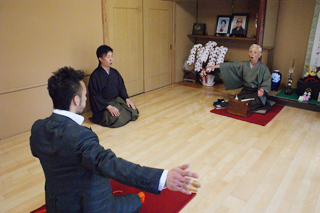
Once you’re able to produce good sound, then you need to pay attention to ”how you look”. ”How you appear and present yourself is important too.” Additional advice was given.
The right arm should be held a little lower than the shoulder, not directly by your side, but diagonally forward. The ohzutsumi should be hit from this angle. This movement will create a unique moment of tension, an instant before hitting the ohzutsumi. After the lesson, Nakata looks at his palm which had turned bright red. ”This hurts. Now I understand what you meant.” Nakata laughed.
Sitting up straight, striking the ohzutsumi, and giving signal calls. We now understood the basics of Noh performance.
Kamei shared words of encouragement as we continued our travels. ”Please continue your journey so that you can discover more wonderful things about Japanese culture that can be shared with the world.”



